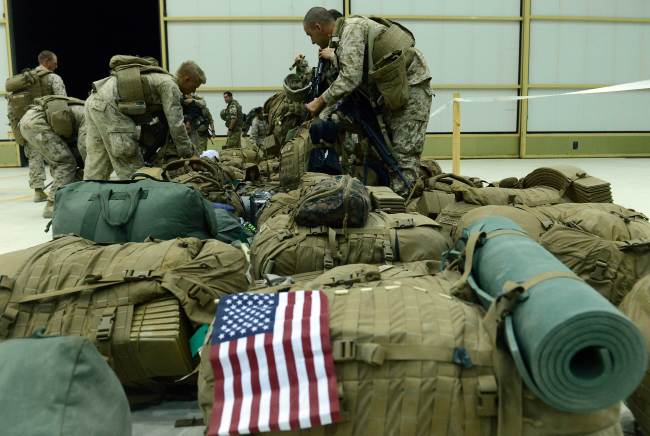Demolition derby at huge U.S. base as Afghan exit quickens
By Korea HeraldPublished : Nov. 9, 2014 - 20:42
BAGRAM AIR BASE, Afghanistan (AFP) ― First they remove the power supply, then they tear out fixtures by hand, before a mechanical digger destroys the roof in a cloud of dust ― the U.S. military is ending its war in Afghanistan and the wrecking crews are busy.
At Bagram airfield, the largest U.S. base in the country, 1,800 temporary buildings have been destroyed this year as the massive NATO-led fighting force pulls out after more than a decade battling Taliban insurgents.
The wooden offices and dormitories being razed to the ground were hurriedly erected at Bagram as troops first arrived in the country after 2001 and when the U.S. sent an extra 30,000 soldiers in the 2010 “surge.”
At the height of the war, 130,000 international troops were fighting in Afghanistan, but combat operations will finish at the end of the year and only 12,500 soldiers will remain into 2015 on a training and support mission.
At Bagram airfield, the largest U.S. base in the country, 1,800 temporary buildings have been destroyed this year as the massive NATO-led fighting force pulls out after more than a decade battling Taliban insurgents.
The wooden offices and dormitories being razed to the ground were hurriedly erected at Bagram as troops first arrived in the country after 2001 and when the U.S. sent an extra 30,000 soldiers in the 2010 “surge.”
At the height of the war, 130,000 international troops were fighting in Afghanistan, but combat operations will finish at the end of the year and only 12,500 soldiers will remain into 2015 on a training and support mission.

“This is definitely a full-time job for us,” said U.S. Staff Sgt. Zach Smith, head of one of the demolition teams at Bagram, 50 kilometers north of Kabul.
“Part of the process is removing all the interior rooms and electrical components and separating them so they can be properly disposed of.”
Soldiers wearing yellow hardhats use crowbars and hammers to dismantle the vacated buildings that once housed desks, computers and bunk beds.
The work is fast but painstaking as material is sifted into different components for recycling or disposal, ensuring that no electrical items or other potential bomb-making kit can fall into Taliban hands.
“We absolutely do that in the most environmentally-conscious way that we possibly can,” Smith said.
“Whenever there is fuel, oil, batteries, we dispose of those things to ensure that we leave Bagram the way we found it.”
The splintered remains of each building are scooped into dumper trucks that make endless journeys back and forth to a tipping site on the edge of the base.
Dubbed “Mount Trash-more” after Mount Rushmore ― the U.S. mountain carved into the faces of former presidents ― the dump is opened to Afghan companies who salvage what they can from the debris.
“Right now we’ve taken down about 1,800 temporary structures that were either living space or offices,” said Lt. Wes Vermillion, who oversees the project.
He said more than 2,000 buildings will be destroyed by December, with a final 500 torn down by contractors next year after the U.S. military engineers have left.
But as the base shrinks, it is also a hub for the “retrograde” operation to remove weapons, equipment and vehicles from Afghanistan as troops draw in from the provinces.
“We have a lot of folks coming in from other bases that we’re sending home,” said Colonel Stephanie Gradford, who plots Bagram’s adaption to its rapidly changing role.
“We are retrograding equipment in preparation (for the NATO support mission) and preparing Bagram to be turned over, at some point in the next couple of years, to the Afghans.”
Cargo aircraft loaded with gear and troops wait on the runway to leave the country, while elsewhere Afghan teams scour the site of a demolished canteen, even picking up spare nails left on the ground.
Bagram’s permanent buildings and roads are being kept for the U.S. forces that will still be deployed next year, and then for the Afghan military that will be left to thwart any Taliban resurgence.
-
Articles by Korea Herald








![[Graphic News] More Koreans say they plan long-distance trips this year](http://res.heraldm.com/phpwas/restmb_idxmake.php?idx=644&simg=/content/image/2024/04/17/20240417050828_0.gif&u=)
![[KH Explains] Hyundai's full hybrid edge to pay off amid slow transition to pure EVs](http://res.heraldm.com/phpwas/restmb_idxmake.php?idx=644&simg=/content/image/2024/04/18/20240418050645_0.jpg&u=20240419100350)








![[KH Explains] Hyundai's full hybrid edge to pay off amid slow transition to pure EVs](http://res.heraldm.com/phpwas/restmb_idxmake.php?idx=652&simg=/content/image/2024/04/18/20240418050645_0.jpg&u=20240419100350)

![[Today’s K-pop] Illit drops debut single remix](http://res.heraldm.com/phpwas/restmb_idxmake.php?idx=642&simg=/content/image/2024/04/19/20240419050612_0.jpg&u=)